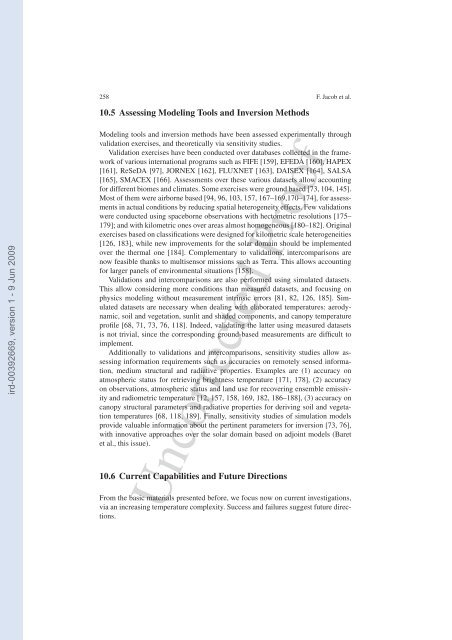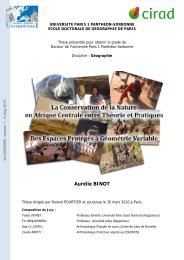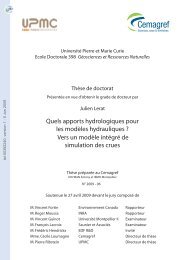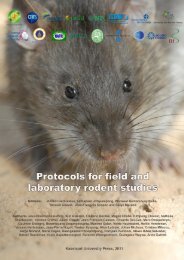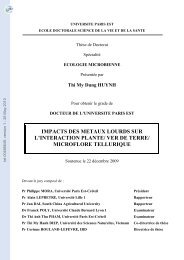Modeling and Inversion in Thermal Infrared Remote Sensing over ...
Modeling and Inversion in Thermal Infrared Remote Sensing over ...
Modeling and Inversion in Thermal Infrared Remote Sensing over ...
Create successful ePaper yourself
Turn your PDF publications into a flip-book with our unique Google optimized e-Paper software.
258 F. Jacob et al.10.5 Assess<strong>in</strong>g <strong>Model<strong>in</strong>g</strong> Tools <strong>and</strong> <strong>Inversion</strong> Methodsird-00392669, version 1 - 9 Jun 2009<strong>Model<strong>in</strong>g</strong> tools <strong>and</strong> <strong>in</strong>version methods have been assessed experimentally throughvalidation exercises, <strong>and</strong> theoretically via sensitivity studies.Validation exercises have been conducted <strong>over</strong> databases collected <strong>in</strong> the frameworkof various <strong>in</strong>ternational programs such as FIFE [159], EFEDA [160], HAPEX[161], ReSeDA [97], JORNEX [162], FLUXNET [163], DAISEX [164], SALSA[165], SMACEX [166]. Assessments <strong>over</strong> these various datasets allow account<strong>in</strong>gfor different biomes <strong>and</strong> climates. Some exercises were ground based [73, 104, 145].Most of them were airborne based [94, 96, 103, 157, 167–169,170–174], for assessments<strong>in</strong> actual conditions by reduc<strong>in</strong>g spatial heterogeneity effects. Few validationswere conducted us<strong>in</strong>g spaceborne observations with hectometric resolutions [175–179]; <strong>and</strong> with kilometric ones <strong>over</strong> areas almost homogeneous [180–182]. Orig<strong>in</strong>alexercises based on classifications were designed for kilometric scale heterogeneities[126, 183], while new improvements for the solar doma<strong>in</strong> should be implemented<strong>over</strong> the thermal one [184]. Complementary to validations, <strong>in</strong>tercomparisons arenow feasible thanks to multisensor missions such as Terra. This allows account<strong>in</strong>gfor larger panels of environmental situations [158].Validations <strong>and</strong> <strong>in</strong>tercomparisons are also performed us<strong>in</strong>g simulated datasets.This allow consider<strong>in</strong>g more conditions than measured datasets, <strong>and</strong> focus<strong>in</strong>g onphysics model<strong>in</strong>g without measurement <strong>in</strong>tr<strong>in</strong>sic errors [81, 82, 126, 185]. Simulateddatasets are necessary when deal<strong>in</strong>g with elaborated temperatures: aerodynamic,soil <strong>and</strong> vegetation, sunlit <strong>and</strong> shaded components, <strong>and</strong> canopy temperatureprofile [68, 71, 73, 76, 118]. Indeed, validat<strong>in</strong>g the latter us<strong>in</strong>g measured datasetsis not trivial, s<strong>in</strong>ce the correspond<strong>in</strong>g ground-based measurements are difficult toimplement.Additionally to validations <strong>and</strong> <strong>in</strong>tercomparisons, sensitivity studies allow assess<strong>in</strong>g<strong>in</strong>formation requirements such as accuracies on remotely sensed <strong>in</strong>formation,medium structural <strong>and</strong> radiative properties. Examples are (1) accuracy onatmospheric status for retriev<strong>in</strong>g brightness temperature [171, 178], (2) accuracyon observations, atmospheric status <strong>and</strong> l<strong>and</strong> use for rec<strong>over</strong><strong>in</strong>g ensemble emissivity<strong>and</strong> radiometric temperature [12, 157, 158, 169, 182, 186–188], (3) accuracy oncanopy structural parameters <strong>and</strong> radiative properties for deriv<strong>in</strong>g soil <strong>and</strong> vegetationtemperatures [68, 118, 189]. F<strong>in</strong>ally, sensitivity studies of simulation modelsprovide valuable <strong>in</strong>formation about the pert<strong>in</strong>ent parameters for <strong>in</strong>version [73, 76],with <strong>in</strong>novative approaches <strong>over</strong> the solar doma<strong>in</strong> based on adjo<strong>in</strong>t models (Baretet al., this issue).10.6 Current Capabilities <strong>and</strong> Future DirectionsUncorrected ProofFrom the basic materials presented before, we focus now on current <strong>in</strong>vestigations,via an <strong>in</strong>creas<strong>in</strong>g temperature complexity. Success <strong>and</strong> failures suggest future directions.


